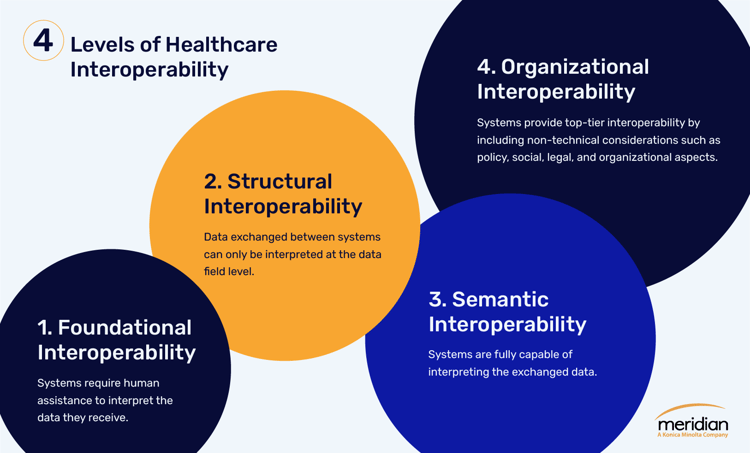The healthcare industry is in the midst of a transition, driven by cost-reduction goals and patient demand for simplified clinical, health, and financial information access.
To achieve these goals, healthcare organizations must reevaluate their document management processes and optimize their electronic health records (EHRs) and health information exchange (HIE) services. When physicians, nurses, and support personnel rely on manual document processes, health information management becomes daunting, complex, and time-consuming.
Healthcare providers need the ability to exchange information between applications, databases, and other content management systems regardless if different manufacturers in different industries developed the software.
To improve patient-centric care and document accessibility, healthcare organizations need to recognize the importance of interoperability and the primary challenges barring effective adoption and implementation.
What is Interoperability and Why is it Essential for Healthcare Organizations?
The multitude of software platforms, content management systems (CMS), and databases used in healthcare facilities are meant to streamline document processes and improve data accessibility. Instead, providers are finding that the tools created by different companies are not designed for compatibility and seamless integration into their proprietary systems. The sheer number of systems is just one of the many barriers preventing healthcare organizations from achieving streamlined health information exchange.
Healthcare organizations need a unified approach for exchanging, capturing, storing, and retrieving data and documents in a way that is private, secure, and follows all industry and HIPAA protocols.
This is where interoperability comes into play.
Interoperability refers to the ability of two or more computer systems to exchange, communicate and make use of information. For healthcare organizations, interoperability enables healthcare providers to access, gather, integrate, and share electronic health information quickly and securely to optimize patient processes.
The Healthcare Information and Management Systems Society (HIMSS) defines interoperability as:
“The extent to which systems and devices can exchange data, and interpret that shared data. For two systems to be interoperable, they must be able to exchange data and subsequently present that data such that it can be understood by a user.”
From a healthcare provider’s perspective, content management system (CMS) compatibility is at the heart of inefficient processes. A lack of interoperability can affect multiple areas of operations, from revenue to reimbursement to patient satisfaction and provider burnout.
Healthcare organizations prioritizing interoperability will improve patient experience, staff productivity, and data exchange capabilities, ensuring quick and secure gathering and sharing of electronic health records.
What are the Four Levels of Health Information Technology Interoperability?
The HIMSS board created a multi-tiered framework to help healthcare organizations assess their level of adoption. When reviewing the four levels of healthcare interoperability, attempt to evaluate your organization’s information management capabilities so you can identify areas to improve
Visibility and comprehension of your healthcare organization’s document management processes will help facilitate future conversations with intelligent information management service providers.

1. Foundational
Also known as simple transport, foundational interoperability is the most basic level and refers to a system or software’s capability to exchange healthcare data to a separate system. At this level, systems can securely communicate and receive data from other systems but cannot interpret the patient data without human assistance.
For example, suppose a doctor wants to download a PDF file of a patient’s lab report via a patient portal. In that case, they will have to manually transfer the data from the PDF into the electronic medical record (EMR) system.
2. Structural
Also known as structured transport, structural interoperability refers to the standardization of data to a particular format to enable interpretation by multiple document management systems or devices. At this level, data is categorized and organized into a specific order to ensure the receiving system can automatically detect predetermined data fields.
Data standards such as FHIR and HL7 provide healthcare organizations with a framework to achieve structural interoperability, ensuring electronic healthcare information exchange remains consistent, centralized, and easy to move between systems.
3. Semantic
Also known as semantic transport, semantic interoperability refers to the capability of multiple systems to interpret and exchange individual data elements with completely different data structures. The goal of semantic interoperability is to ensure that the exchanging systems have a shared comprehension of the semantic meaning of an individual concept, such as a particular procedure, diagnosis, or lab result.
At this level, patient data can transfer from one system to another for quick interpretation and integration into the receiving system regardless of the data’s original format or source.
4. Organizational
Organizational interoperability is the highest level and refers to seamless exchange and integration of patient data between various organizations with different goals, regulations, and requirements. Since this level of interoperability deals with the transfer of data between other groups, healthcare organizations will need to consider non-technical innovations such as policy, legal, social, and organizational aspects to ensure smooth and secure Health Information Exchange (HIE).
Enhance Patient Care and Support Compliance with Intelligent Information Management Services
It’s time for the healthcare industry to retire cumbersome and costly paper workflows and adopt a centralized and comprehensive content management system that promotes interoperability and patient-centric care.
Healthcare facilities should partner with a trusted intelligent information management service provider to implement a cost-effective document management system tailored to their healthcare organization.




